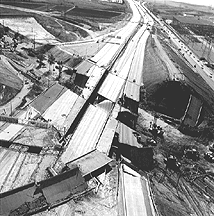
A devastating fire followed the 1906 earthquake in San Francisco
(photo from the P.E. Hotz Collection, USGS Library, Menlo Park, California)
Full size image - 128k

A great earthquake very possibly will not occur unannounced. Such an earthquake may be preceded by an increase in seismicity for several years, possibly including several foreshocks of about magnitude 5 along the fault. Before the next large earthquake, seismologists also expect to record changes in the Earth's surface, such as a shortening of survey lines across the fault, changes in elevation, and effects on strainmeters in wells. A key area for research on methods of earthquake prediction is the section of the San Andreas fault near Parkfield in central California, where a moderate-size earthquake has occurred on the average of every 20-22 years for about the last 100 years. Since the last sizeable earthquake occurred in 1966, Parkfield has a high probability for a magnitude 5-6 earthquake before the end of this century and possibly one may occur within a few years of 1988. The U.S. Geological Survey has placed an array of instruments in the Parkfield area and is carefully studying the data being collected, attempting to learn what changes might precede an earthquake of about that size.

The San Fernando earthquake of 1971 collapsed freeway overpasses in southern California
(photo by Robert E. Wallace)
Full size image - 95k